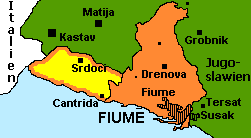Italian reign on Quarnero
|
Italian reign at Quarnero Reggenza Italiana del Carnaro Repubblica del Carnaro 1919–1920 |
|||||
|---|---|---|---|---|---|
|
|||||
|
|||||
| Motto | Quis contra nos? | ||||
| Constitution | Carta del Carnaro | ||||
| Official language | Italian | ||||
| Capital | Fiume | ||||
| Form of government | republic | ||||
| Form of government | Parliamentary democracy | ||||
| Head of state | Gabriele D'Annunzio | ||||
| Head of government |
Head of Cabinet Giovanni Guirinati (1919) Alceste de Ambris (1919–1920) |
||||
| surface | 21 km² (1920) | ||||
| Residents | 50,000 (1920) | ||||
| Population density | 2381 inhabitants / km² | ||||
| currency |
Austrian crown Italian lira |
||||
| founding | September 12, 1919 (Fiume is occupied by the Arditi) |
||||
| resolution | November 12, 1920 ( Rapallo Border Treaty ) |
||||
| National anthem | unknown | ||||
| Time zone | CET | ||||

|
|||||
The Italian reign on the Quarnero ( Italian : Reggenza Italiana del Carnaro ) was proclaimed on September 8, 1920 by Gabriele D'Annunzio in Fiume (now Rijeka in Croatia ). The Kvarner Bay ( Italian : Golfo del Quarnero , also Quarnaro , Carnaro ; Croatian : Kvarnerski zaljev ), on which the city is located, gave the state structure its name. The Italian reign on Quarnero remained without international recognition and was replaced by the Free State of Fiume in December 1920 .
History of the reign
The multiethnic, mostly populated by Italians port city of Fiume on the Adriatic coast belonged to the First World War to Austria-Hungary , and had within the Habsburg Monarchy a special status ( corpus separatum ) . After the defeat of the dual monarchy and its collapse, the Prime Ministers of France and Great Britain, Georges Clemenceau and Lloyd George , agreed with the Italian Foreign Minister Tommaso Tittoni to place Fiume as a Free City under the supervision of the League of Nations . They were just waiting for US President Woodrow Wilson's approval . The peace treaty of Saint Germain , which was signed on September 10, 1919 between the victorious powers and Austria, did not regulate the Fiume question.
On September 12, 1919, 2,500 Italian irregulars, led by the Italian nationalist and writer Gabriele D'Annunzio, the so-called Arditi , and parts of the regular Italian army occupied the city and drove the Allied Control Commission out. D'Annunzio wanted to secure Fiume and the surrounding area for Italy before the indecisive Entente states would award the city to the Kingdom of Serbs, Croats and Slovenes . The occupiers hoped that the Fiume area would be annexed by the Kingdom of Italy , but were disappointed. The Italian government under the left-wing liberal Francesco Saverio Nitti instead imposed a blockade on the city and called on the irregulars to give up.
D'Annunzio proclaimed the Italian reign on Quarnero and gave the state Repubblica del Carnaro a constitution that suggested many details of the later fascist system , but which also provided for revolutionary social reforms; including the legal recognition of trade unions , freedom of the press and the right to vote for women . Symbols and rituals emerged here that were later adopted by Italian and German fascists: uniforms, ceremonies, speeches from the balcony, dialogues with listeners, songs and battle cries as well as the Roman salute with the right arm. Under D'Annunzio's eccentric leadership, which was manifested in extravagant celebrations, alcohol and drug consumption, and sexual escapades, Fiume was also a magnet for Italian and European artists. So visited z. B. the founder of Futurism Filippo Tommaso Marinetti the small state and Arturo Toscanini gave concerts with his orchestra in Fiume.
Both the Treaty of Trianon between the victorious powers and Hungary and the Rapallo border treaty between Italy and the Kingdom of Serbs, Croats and Slovenes of November 12, 1920 declared Fiume an independent free state . However, D'Annunzio ignored them and declared war on Italy on December 21st. After the shelling of his palace by the Italian warship Andrea Doria and the battles of the "Bloody Christmas" from December 24th to December 30th, 1920, the legionaries finally surrendered the city.
The Carta del Carnaro
history
After the occupation of the port city of Fiume, the living conditions for the population deteriorated considerably as a result of the blockade of the access roads. Unrest spread. It was unclear how the Italian government under Francesco Saverio Nitti would react. After the resignation of his nationalist cabinet chief Giovanni Guirinati on December 23, 1919, D'Annunzio appointed the well-known anarcho-syndicalist Alceste de Ambris as his successor. He gave him the job of drafting a constitution for the new state .
After two and a half months, D'Annunzio received the draft constitution on March 18, 1920, which he then revised and added to. After its announcement on August 30, 1920, the Carta came into force on September 8, 1920 at the same time as the general strike in Italy. It should become a model for a new way of living together and a role model for all of Italy. D'Annunzio temporarily hoped for a revolution together with the socialists after a march on Rome and the establishment of a republic of Italy.
But since the events in Fiume in the autumn and winter of 1920 precipitated, the Carta was no longer implemented. Few structural elements such as the participation of corporations were taken up by the fascists under Mussolini in the following years . The latter rejected the Carta as a whole because it was too liberal for him.
content
The Carta del Carnaro was a constitution that contained anarchist, proto-fascist, and democratic elements. The constitution with its 65 articles contained the following basic and human rights :
- full equality between men and women
- active and passive voting rights for women
- Tolerance between religions and atheists
- a strict separation between state and church.
A compensation for miscarriage of justice with liability of the public officials and compensation for those affected in the event of abuse of power was provided. Citizens were able to exert influence within the framework of direct democracy through referendums and referendums . They were entitled to a minimum wage , comprehensive social security, health and retirement benefits. The schools should educate without any religious and political indoctrination.
The property should also develop a social impact. Rights were derived from the obligation to work. Productive work was seen as an important element of the state. One wanted to overcome the alienation of work after Karl Marx .
Political leadership positions were only awarded for a limited period and without accumulating offices in order to avoid static bureaucracy and to offer the next generation a career opportunity. Conflicts should be resolved by consensus. That is why there were no regulations for voting.
The handwriting of the writer D'Annunzio was particularly evident in the field of culture, because aesthetic and musical education were very important to him. As a syndicalist, the author De Ambris emphasized the design of autonomous corporations instead of parties. He specified nine corporations, which were assigned to different professional areas (e.g. workers, persons with management functions, employers, teachers and students, seafarers and artists). 60 delegates were elected to a “Council of Commissioners” (Consiglio dei Provvisori). This regulated labor and business law twice a year. A second chamber, the “Council of the Best” (Consiglio degli Ottimi), regulated public order, education and the fine arts. Every 1000 citizens who were over 20 years old elected a delegate. Both chambers together formed the National Council, determined the reign with seven ministers and the commanding officer and the five courts with the constitutional court at the head.
The tenth corporation was supposed to develop mystical powers and, according to the old Tuscan motto “work without exhaustion”, supply the reign with creative energy. State choirs and instrumental groups should be established in all municipalities. According to the Roman model, aediles were supposed to improve civil life. In order to ensure room for maneuver, many regulations for the municipalities remained indefinite. A strict separation of powers was observed. In the event of an emergency, the commanding officer was allowed to establish a dictatorship for a period of six months.
literature
- Renzo de Felice: La Carta del Carnaro . Bologna 1974. (Italian text from the Carta)
- Hans Ulrich Gumbrecht : The poet as a commandant. D'Annunzio conquers Fiume . 1996. (also contains the German translation of the Carta, pp. 49-66)
- Michael A. Ledeen: The First Duce . Baltimore 1977. (historical classification)
- Hans Gangl: D'Annunzio and De Ambris as constitution-makers . In: Bernd Christian Funk (Ed.): Constitutional Law and Political Science in Change . 1992, p. 105-124 . (legal analysis of the Carta)
- Kersten Knipp: The Fascist Commune. Gabriele D'Annunzio, the Republic of Fiume and the extremes of the 20th century . wbg Theiss, Darmstadt 2018, ISBN 978-3-8062-3914-0 .
Web links
- Stefan Andres: The Death of an Unloved One (PDF file; 107 kB)
- World at War: Fiume (English)
Individual evidence
- ↑ a b Birte Förster : 1919. A continent is reinventing itself. 2nd edition, Reclam, Ditzingen 2018. Section The Beginnings of Italian Fascism and the Occupation of Fiume.



